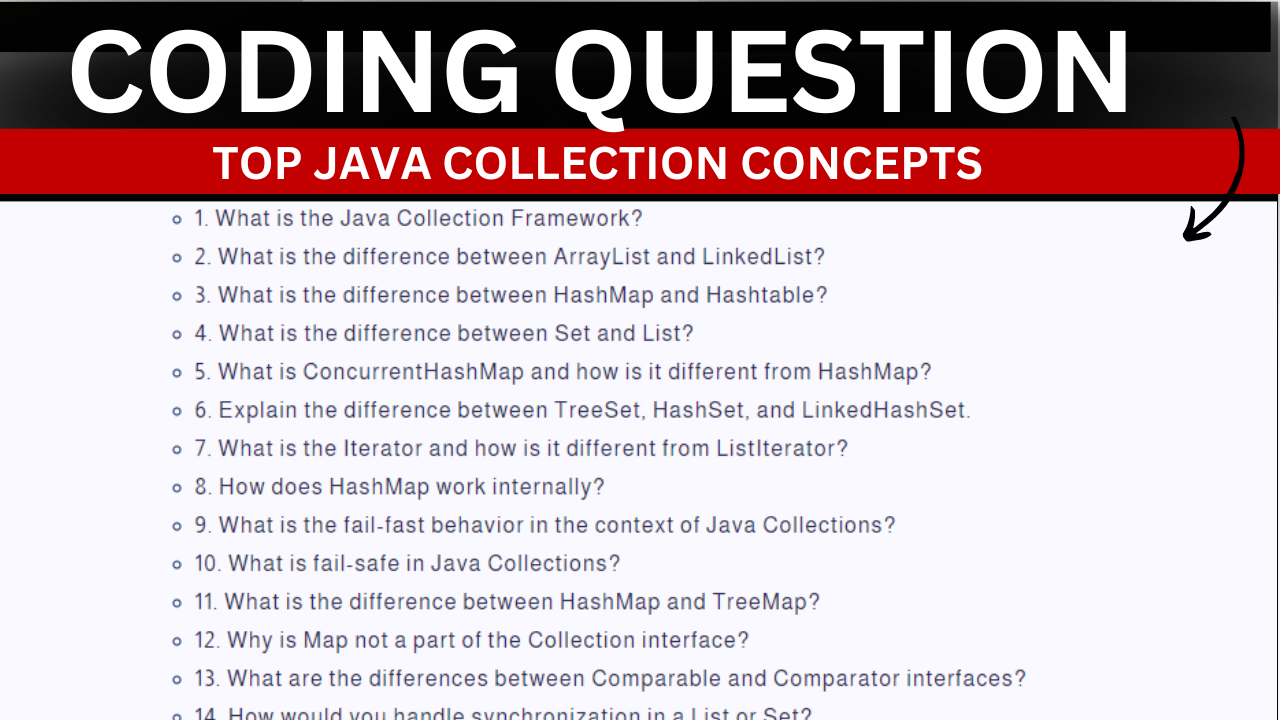Your cart is currently empty!

Top Java Collection Concepts interview questions
Menu
top Java Collection Concepts interview questions specifically tailored for Automation Testers:
1. What is the Java Collection Framework?
- Answer: The Java Collection Framework is a set of interfaces and classes that handle groups of objects, allowing operations such as searching, sorting, insertion, manipulation, and deletion of data. Commonly used interfaces include
List,Set,Map,Queue, andDeque.
2. What is the difference between ArrayList and LinkedList?
- Answer:
- ArrayList: Implements a dynamic array. It allows fast random access but slower insertions and deletions, especially when they happen in the middle of the list.
- LinkedList: Implements a doubly linked list. It’s faster for insertion and deletion but slower for random access, as it needs to traverse nodes.
- Complete Python Course : Click here
- Free Notes :- Click here
- New Project :-https://www.youtube.com/@Decodeit2
- Java Projects – Click here
3. What is the difference between HashMap and Hashtable?
- Answer:
- HashMap: Non-synchronized, allows null keys and values, and is faster.
- Hashtable: Synchronized, doesn’t allow null keys or values, and is slower due to thread safety.
4. What is the difference between Set and List?
- Answer:
- List: Allows duplicates, maintains insertion order.
- Set: Does not allow duplicates, does not maintain any specific order (except
LinkedHashSetwhich does).
5. What is ConcurrentHashMap and how is it different from HashMap?
- Answer:
ConcurrentHashMapis thread-safe and designed for concurrent operations without locking the entire map, which ensures better performance in a multi-threaded environment.HashMap, on the other hand, is not thread-safe.
6. Explain the difference between TreeSet, HashSet, and LinkedHashSet.
- Answer:
- TreeSet: Stores elements in a sorted order (according to natural ordering or custom comparator).
- HashSet: Stores elements without any order.
- LinkedHashSet: Maintains insertion order of elements.
7. What is the Iterator and how is it different from ListIterator?
- Answer:
- Iterator: Can traverse the elements of a collection only in a forward direction.
- ListIterator: Can traverse in both directions (forward and backward) and allows modification of elements during iteration.
8. How does HashMap work internally?
- Answer:
HashMapworks by using a hash function to compute an index into an array of buckets. When collisions occur (two keys producing the same hash), it stores the entries as a linked list in that bucket. In Java 8, this linked list is converted to a balanced tree (red-black tree) for better performance when collisions are frequent.
9. What is the fail-fast behavior in the context of Java Collections?
- Answer: Collections like
ArrayListandHashMapthrowConcurrentModificationExceptionwhen they detect a structural modification while iterating, except through the iterator itself. This behavior is known asfail-fast.

10. What is fail-safe in Java Collections?
- Answer:
fail-safeiterators operate on a copy of the collection, allowing modification during iteration without throwingConcurrentModificationException. Examples includeConcurrentHashMapandCopyOnWriteArrayList.
11. What is the difference between HashMap and TreeMap?
- Answer:
- HashMap: Unordered collection, allows null keys.
- TreeMap: Ordered collection, doesn’t allow null keys, and sorts elements based on their natural order or a custom comparator.
12. Why is Map not a part of the Collection interface?
- Answer:
Maprepresents a key-value pair, whileCollectionrepresents a group of individual objects. The two concepts are different, and hence,Mapwas kept as a separate interface.

13. What are the differences between Comparable and Comparator interfaces?
- Answer:
- Comparable: Used for natural ordering, defined in the class itself by implementing the
compareTomethod. - Comparator: Used for custom ordering, defined outside the class by implementing the
comparemethod.
- Comparable: Used for natural ordering, defined in the class itself by implementing the
14. How would you handle synchronization in a List or Set?
- Answer: You can use
Collections.synchronizedList()orCollections.synchronizedSet()to create a synchronized version of these collections. Alternatively, you can use thread-safe collections likeCopyOnWriteArrayListorConcurrentSkipListSet.
/
15. What are the best practices for using Collections in automation testing?
- Answer:
- Use the right collection for the job (e.g.,
ArrayListfor quick access,LinkedListfor frequent insertions/removals). - Prefer
ConcurrentHashMaporCopyOnWriteArrayListin multi-threaded environments. - Leverage
Comparatorfor sorting test data effectively.
- Use the right collection for the job (e.g.,
Post Views: 472
collections in java java collection coding interview questions java collection programming exercises java collection programs for interview java collections coding interview questions and answers for experienced java collections interview questions for 10 years experience scenario based collection interview questions tricky java collection interview questions
Leave a Reply